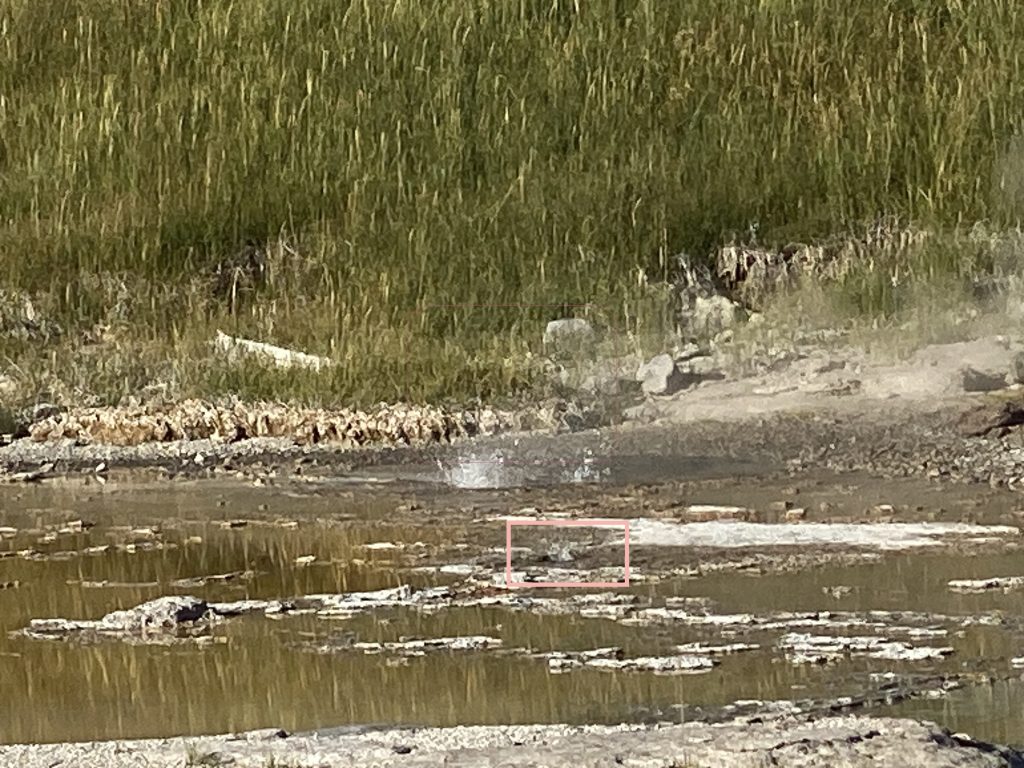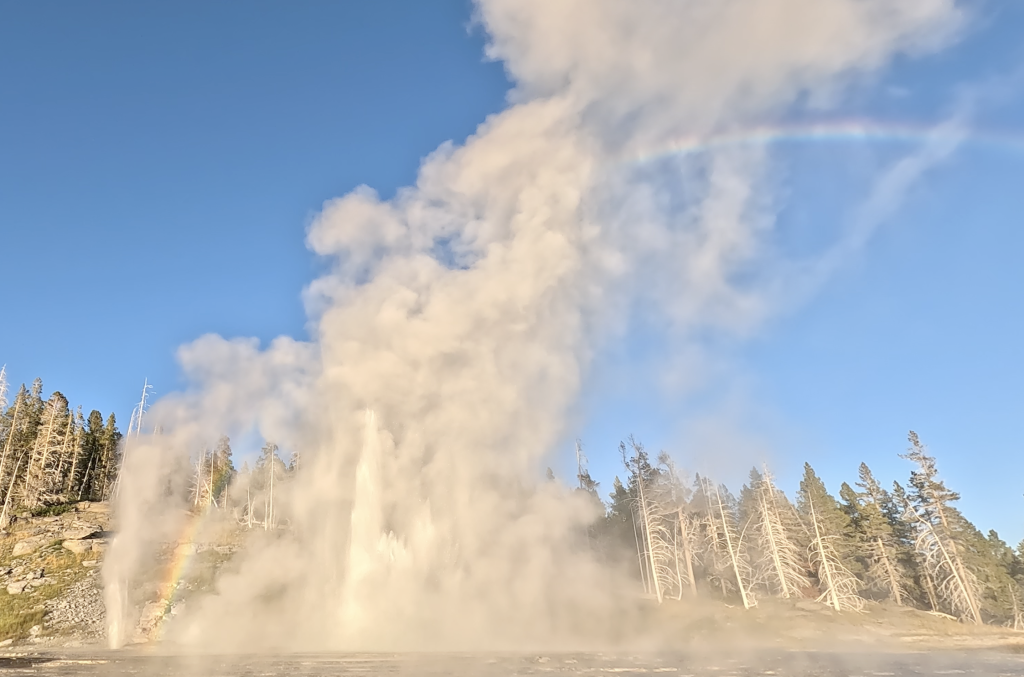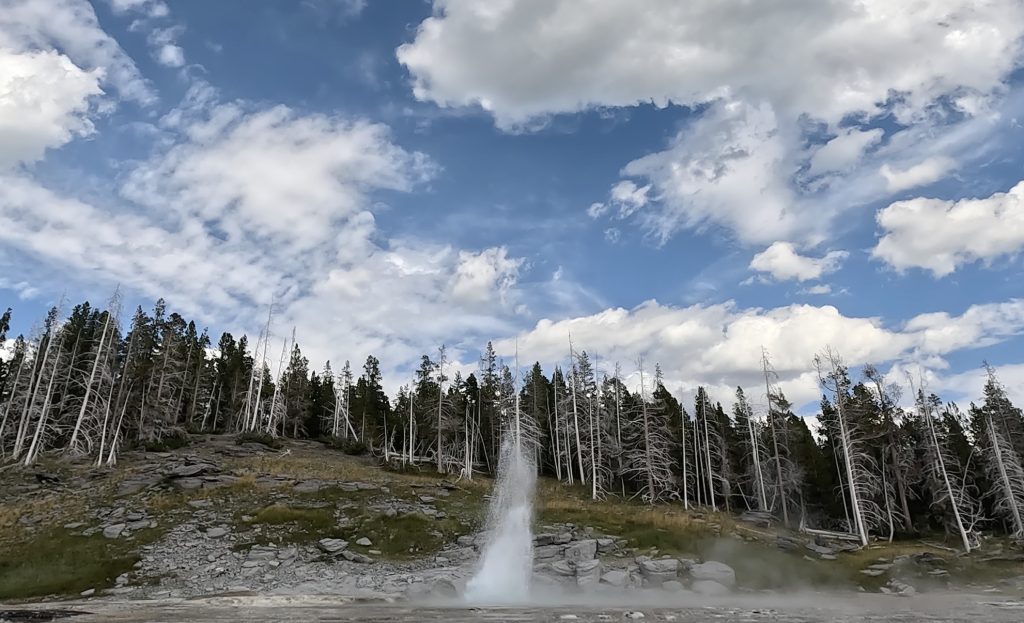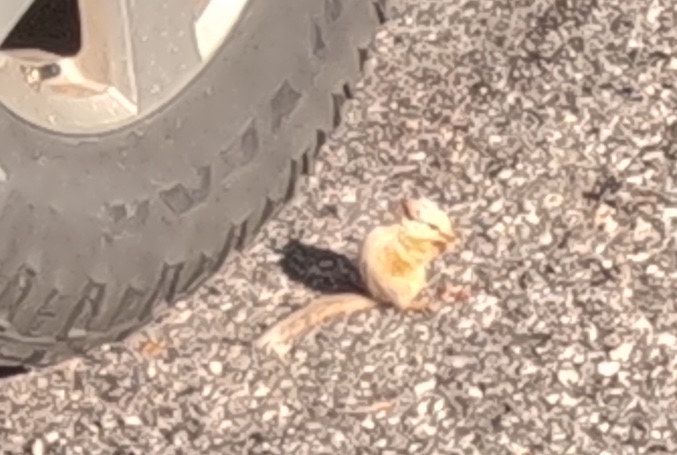As expected, there was a thick fog over the basin when I went out at dawn. Got over to Grand and then heard Castle start to erupt. Seems like Turban had had a delay, and we ended with what was probably a six Turban Interval Delay. The One Burst Grand Eruption lasted nearly eleven minutes.
2023-Aug-06:08:11:34 G1Q
08:11:26 Boop -0m08s
08:11:34 Grand B1 --- d=10m55s
08:12:00 Vent Ovfl 0m25s
08:12:15 Turban 0m40s
08:14:48 Vent 3m14s
08:22:30 P1 10m55s
08:23:15 V&T Quit 11m41s
ΣD=10m55s
* * * * *
06:27:41 d=3m05s
06:43:00 Int: 15m19s d=3m11s
07:02:04 Int: 19m04s d=3m50s
07:20:33 Int: 18m29s d=3m57s
07:38:56 Int: 18m23s d=4m02s
07:54:34 Int: 15m38s d=3m40s
Grand: 17m00s
Walking away from Grand, there was sudden movement next to the boardwalk as I passed Bulger. It was a rabbit. I was moving alongside and under the boardwalk. The last I saw of it, it had disappeared under the walkway toward the river at Sawmill. I don't remember ever seeing a rabbit in the Upper Basin.
Every time I thought I was reconfigured to go out to Geyser Hill, I came back and made another change. The fog had cleared and the sun was out, but the air temperature was low. While waiting for Beehive, saw an eruption of Depression, and then Dome. This was mostly bursts above the rim. Went around to take a closer look, and noticed no water coming down the runoff.
There were several more Dome eruptions during the wait. Concensus is that the series started overnight, and the subequent eruptions were lost in the fog until that finally cleared.
Thought I was headed out to Grand early, in order to get settled in before the thunderstorms started. I got sprinkled on walking between Castle and Grand. Arrived in time to see the start of a Turban eruption, which turned in the one before a Turban Interval Delay. The pool that time was full, but never looked good, and the interval was just under 28 minutes.
Two Turban eruption intervals later, Grand was full and overflowing heavily when in quick succession there was a Vent overflow, Grand start and then Turban starting. The burst lasted almost 9-1/4 minutes, and we got a nice second burst pushing through the steam.
2023-Aug-06:14:44:44 D2/G2Q
14:44:34 Vent Ovfl -0m09s
14:44:41 Boop -0m02s
14:44:44 Grand B1 --- d=9m12s
14:44:47 Turban 0m03s
14:47:45 Vent 3m01s
14:53:56 P1 9m12s d=0m43s
14:54:40 B2 9m56s d=0m49s
14:55:29 P2 10m45s
14:56:34 V&T Quit 11m50s
ΣB=10m01s ΣD=10m45s
* * * * *
13:39:46 d=4m25s
14:07:39 Int: 27m53s d=5m00s D0
14:25:40 Int: 18m01s d=4m05s D1
Grand: 19m03s
Just before the Grand eruption there was a report of "snow and ice" on the road over Craig Pass. Right after the eruption, the NPS closed the road. We got to experience pea sized hail on the walk between Sawmill and Castle, and sky to the south was uncommonly black. From the radio, I also heard that strong storms and hail could be expected for the next three hours.
Also on the ride back from Grand, in front of the Inn I encounted a woman riding a bike, holding a phone and looking backwards to take video of the two people riding bikes behind her.
Around sunset got a call about a good looking Fan & Mortar event cycle, with some Bottom vent activity. Since I had not had the opportunity to get down there, and it was an hour before it was time to get to Grand, decided to check it out. One change from last year was that Angle was off when I got there. It didn't join in until after Gold vent started. Otherwise, nothing much happened.
Because of the heavy rains during the afternoon, Belgian Pool was full and murky. What was surprising was that Crystal was also full and overflowing. The caused Slurp to be flooded, and it was actually slurping instead of being a noisy fumarole. Bulger was also having minor eruptions.
Over at Grand, waited one Turban interval for the start of the One Burst Grand Eruption. There was plenty of light to see it, but the wind was such that it was really only visible near West Triplet. The eruption lasted 11m01s, and despite the length, Vent & Turban did not quit.




